Abstract
OBJECTIVES. The purpose of this study was to investigate the relationship between socioeconomic disadvantage and the incidence of severe childhood injury. METHODS. Small-area analysis was used to examine socioeconomic risk factors for pediatric injury resulting in hospitalization or death in Northern Manhattan, New York, NY, during a 9-year period (1983 through 1991). RESULTS. The average annual incidence of all causes of severe pediatric injury was 72.5 per 10,000 children; the case-fatality rate was 2.6%. Census tract proportions of low-income households, single-parent families, non-high school graduates, and unemployment were significant predictors of risk for both unintentional and intentional injury. Among the socioeconomic factors considered, low income was the single most important predictor of all injuries; other socioeconomic variables were not independent contributors once income was included in the model. Compared with children living in areas with few low-income households, children in areas with predominantly low-income households were more than twice as likely to receive injuries from all causes and four and one half times as likely to receive assault injuries. The effect of neighborhood income disparities on injury risk persisted after race was controlled. CONCLUSIONS. These results illuminate the impact of socioeconomic disparities on child health and point to the need for injury prevention efforts targeting low-income neighborhoods.
Full text
PDF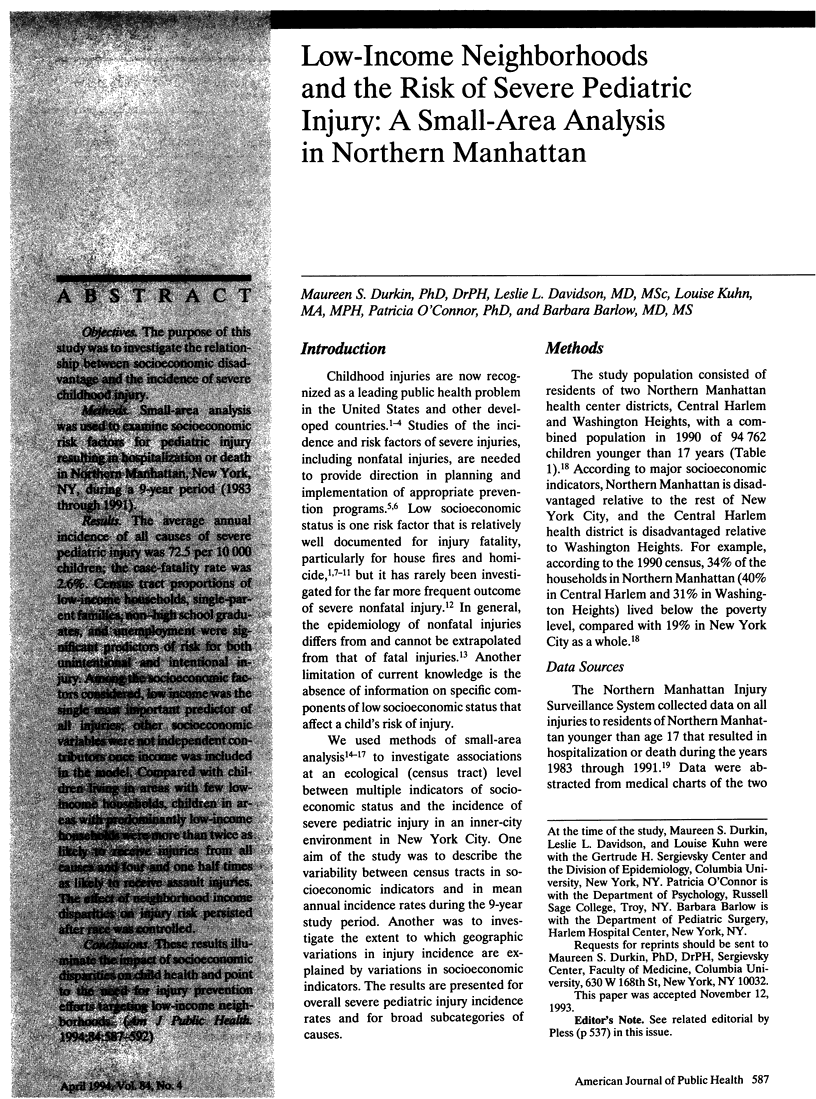
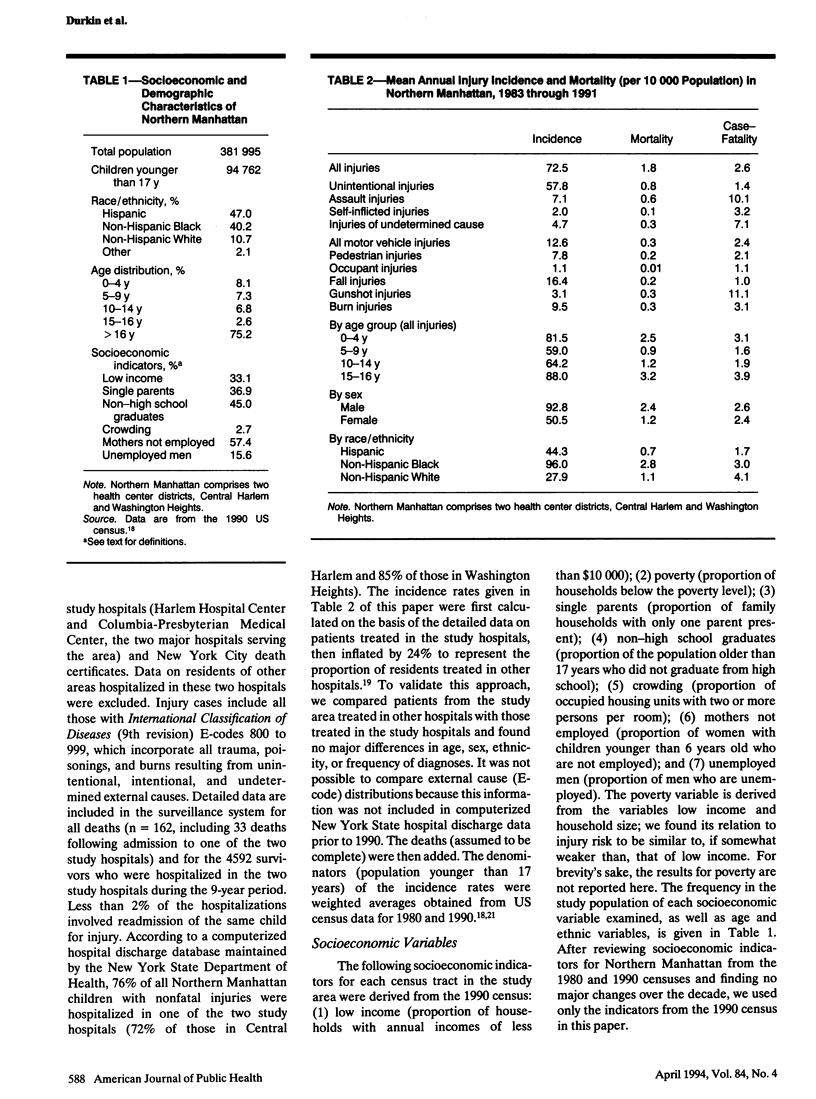
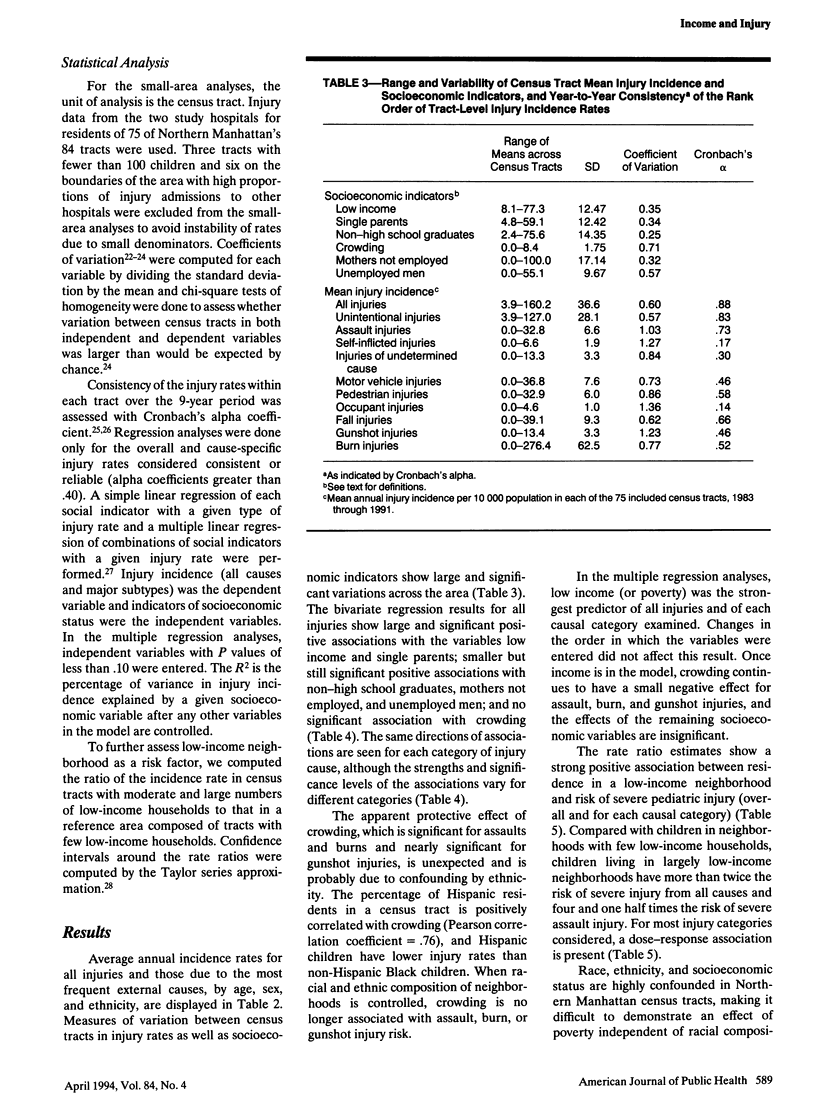
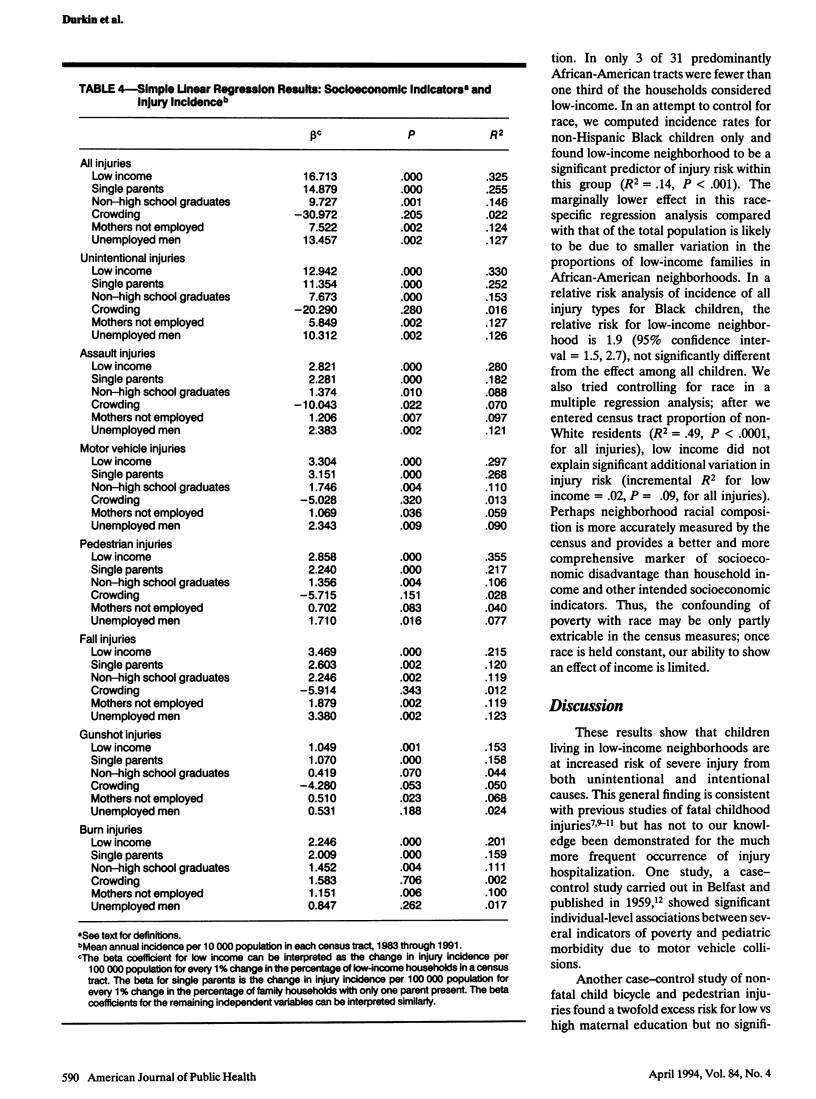
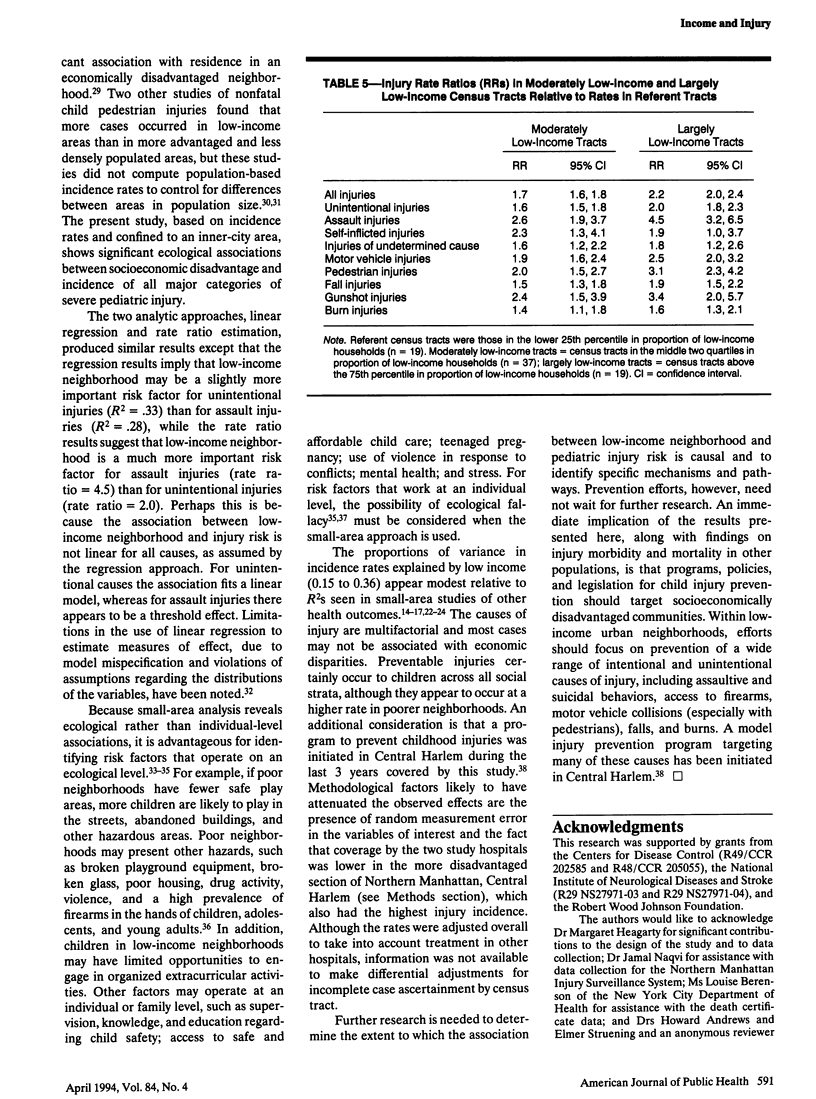
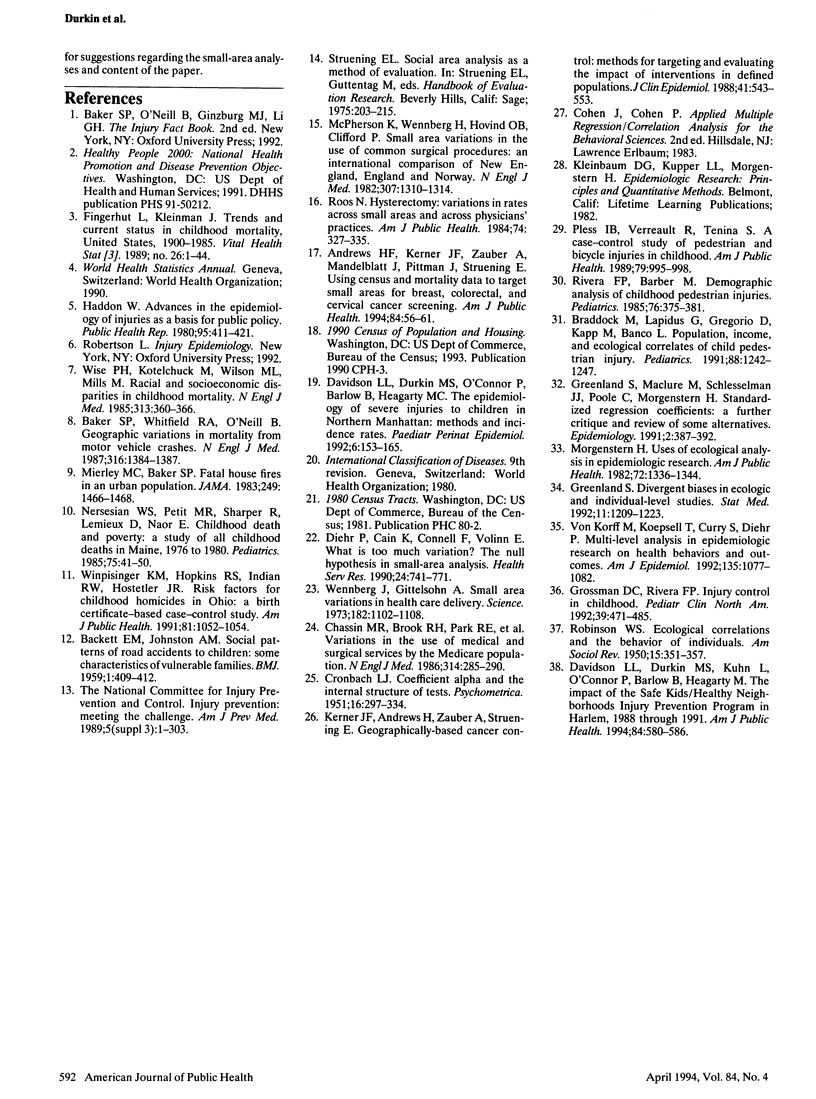
Selected References
These references are in PubMed. This may not be the complete list of references from this article.
- Andrews H. F., Kerner J. F., Zauber A. G., Mandelblatt J., Pittman J., Struening E. Using census and mortality data to target small areas for breast, colorectal, and cervical cancer screening. Am J Public Health. 1994 Jan;84(1):56–61. doi: 10.2105/ajph.84.1.56. [DOI] [PMC free article] [PubMed] [Google Scholar]
- BACKETT E. M., JOHNSTON A. M. Social patterns of road accidents to children; some characteristics of vulnerable families. Br Med J. 1959 Feb 14;1(5119):409–413. doi: 10.1136/bmj.1.5119.409. [DOI] [PMC free article] [PubMed] [Google Scholar]
- Baker S. P., Whitfield R. A., O'Neill B. Geographic variations in mortality from motor vehicle crashes. N Engl J Med. 1987 May 28;316(22):1384–1387. doi: 10.1056/NEJM198705283162206. [DOI] [PubMed] [Google Scholar]
- Braddock M., Lapidus G., Gregorio D., Kapp M., Banco L. Population, income, and ecological correlates of child pedestrian injury. Pediatrics. 1991 Dec;88(6):1242–1247. [PubMed] [Google Scholar]
- Chassin M. R., Brook R. H., Park R. E., Keesey J., Fink A., Kosecoff J., Kahn K., Merrick N., Solomon D. H. Variations in the use of medical and surgical services by the Medicare population. N Engl J Med. 1986 Jan 30;314(5):285–290. doi: 10.1056/NEJM198601303140505. [DOI] [PubMed] [Google Scholar]
- Davidson L. L., Durkin M. S., Kuhn L., O'Connor P., Barlow B., Heagarty M. C. The impact of the Safe Kids/Healthy Neighborhoods Injury Prevention Program in Harlem, 1988 through 1991. Am J Public Health. 1994 Apr;84(4):580–586. doi: 10.2105/ajph.84.4.580. [DOI] [PMC free article] [PubMed] [Google Scholar]
- Davidson L. L., Durkin M. S., O'Connor P., Barlow B., Heagarty M. C. The epidemiology of severe injuries to children in northern Manhattan: methods and incidence rates. Paediatr Perinat Epidemiol. 1992 Apr;6(2):153–165. doi: 10.1111/j.1365-3016.1992.tb00757.x. [DOI] [PubMed] [Google Scholar]
- Diehr P., Cain K., Connell F., Volinn E. What is too much variation? The null hypothesis in small-area analysis. Health Serv Res. 1990 Feb;24(6):741–771. [PMC free article] [PubMed] [Google Scholar]
- Fingerhut L. A., Kleinman J. C. Trends and current status in childhood mortality. Vital Health Stat 3. 1989 Jan;(26):1–44. [PubMed] [Google Scholar]
- Greenland S. Divergent biases in ecologic and individual-level studies. Stat Med. 1992 Jun 30;11(9):1209–1223. doi: 10.1002/sim.4780110907. [DOI] [PubMed] [Google Scholar]
- Greenland S., Maclure M., Schlesselman J. J., Poole C., Morgenstern H. Standardized regression coefficients: a further critique and review of some alternatives. Epidemiology. 1991 Sep;2(5):387–392. [PubMed] [Google Scholar]
- Grossman D. C., Rivara F. P. Injury control in childhood. Pediatr Clin North Am. 1992 Jun;39(3):471–485. doi: 10.1016/s0031-3955(16)38339-0. [DOI] [PubMed] [Google Scholar]
- Haddon W., Jr Advances in the epidemiology of injuries as a basis for public policy. Public Health Rep. 1980 Sep-Oct;95(5):411–421. [PMC free article] [PubMed] [Google Scholar]
- Kerner J. F., Andrews H., Zauber A., Struening E. Geographically-based cancer control: methods for targeting and evaluating the impact of screening interventions on defined populations. J Clin Epidemiol. 1988;41(6):543–553. doi: 10.1016/0895-4356(88)90058-3. [DOI] [PubMed] [Google Scholar]
- McPherson K., Wennberg J. E., Hovind O. B., Clifford P. Small-area variations in the use of common surgical procedures: an international comparison of New England, England, and Norway. N Engl J Med. 1982 Nov 18;307(21):1310–1314. doi: 10.1056/NEJM198211183072104. [DOI] [PubMed] [Google Scholar]
- Mierley M. C., Baker S. P. Fatal house fires in an urban population. JAMA. 1983 Mar 18;249(11):1466–1468. [PubMed] [Google Scholar]
- Morgenstern H. Uses of ecologic analysis in epidemiologic research. Am J Public Health. 1982 Dec;72(12):1336–1344. doi: 10.2105/ajph.72.12.1336. [DOI] [PMC free article] [PubMed] [Google Scholar]
- Nersesian W. S., Petit M. R., Shaper R., Lemieux D., Naor E. Childhood death and poverty: a study of all childhood deaths in Maine, 1976 to 1980. Pediatrics. 1985 Jan;75(1):41–50. [PubMed] [Google Scholar]
- Pless I. B., Verreault R., Tenina S. A case-control study of pedestrian and bicyclist injuries in childhood. Am J Public Health. 1989 Aug;79(8):995–998. doi: 10.2105/ajph.79.8.995. [DOI] [PMC free article] [PubMed] [Google Scholar]
- Rivara F. P., Barber M. Demographic analysis of childhood pedestrian injuries. Pediatrics. 1985 Sep;76(3):375–381. [PubMed] [Google Scholar]
- Roos N. P. Hysterectomy: variations in rates across small areas and across physicians' practices. Am J Public Health. 1984 Apr;74(4):327–335. doi: 10.2105/ajph.74.4.327. [DOI] [PMC free article] [PubMed] [Google Scholar]
- Von Korff M., Koepsell T., Curry S., Diehr P. Multi-level analysis in epidemiologic research on health behaviors and outcomes. Am J Epidemiol. 1992 May 15;135(10):1077–1082. doi: 10.1093/oxfordjournals.aje.a116207. [DOI] [PubMed] [Google Scholar]
- Wennberg J., Gittelsohn Small area variations in health care delivery. Science. 1973 Dec 14;182(4117):1102–1108. doi: 10.1126/science.182.4117.1102. [DOI] [PubMed] [Google Scholar]
- Winpisinger K. A., Hopkins R. S., Indian R. W., Hostetler J. R. Risk factors for childhood homicides in Ohio: a birth certificate-based case-control study. Am J Public Health. 1991 Aug;81(8):1052–1054. doi: 10.2105/ajph.81.8.1052. [DOI] [PMC free article] [PubMed] [Google Scholar]
- Wise P. H., Kotelchuck M., Wilson M. L., Mills M. Racial and socioeconomic disparities in childhood mortality in Boston. N Engl J Med. 1985 Aug 8;313(6):360–366. doi: 10.1056/NEJM198508083130605. [DOI] [PubMed] [Google Scholar]


